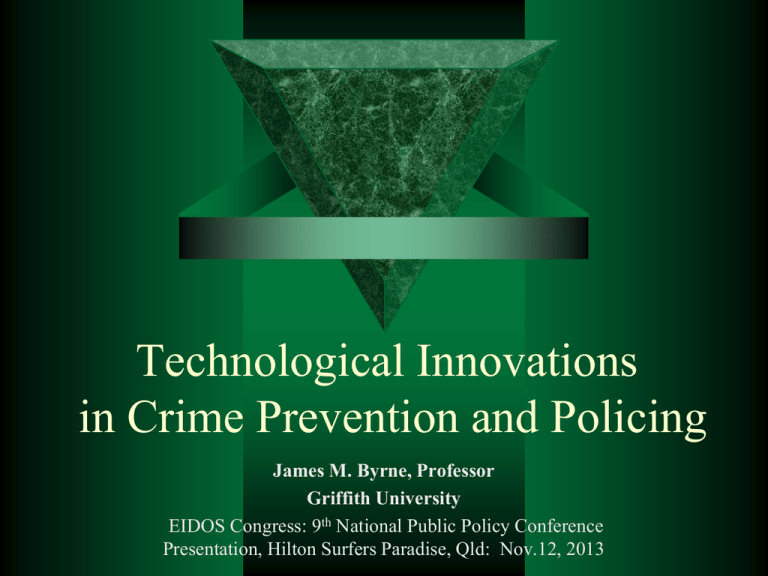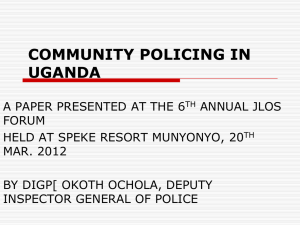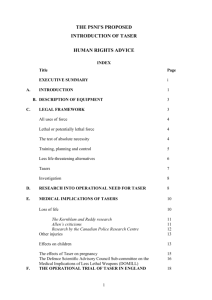
Technological Innovations
in Crime Prevention and Policing
James M. Byrne, Professor
Griffith University
EIDOS Congress: 9th National Public Policy Conference
Presentation, Hilton Surfers Paradise, Qld: Nov.12, 2013
(1) High Quality Corrections and Sentencing Research Agenda- the Centre will develop research
projects focusing on evaluating the impact of current corrections and sentencing strategies( adult/juvenile) in Queensland,
throughout Australia, and internationally.
(2) Knowledge
Exchange Seminars and Systematic, Evidence -based Policy Reviews -To
translate research into practice, the Centre will develop a series of executive session seminars and workshops highlighting
corrections and sentencing issues in each global region.
(3) Global
Evidence-based Corrections and Sentencing Network Development: The
Centre—
through the Centre’s state of the art website-- will become a global clearinghouse for high quality, evidence-based corrections
research, and a primary source of information on global corrections performance, and innovative corrections and sentencing
policies and practices.
WEBPAGE: WWW.GCECS.EDU.AU
Presentation Overview
New Technology of Crime
New Technology of Crime Prevention
New Technology of Policing
Impact of New Technology: Research
Review
Three Issues To Consider
The New Technology of Crime:
New Offenders, New Crimes
The Impact of Technology on Criminality –
New Offenders
3 Distinct Opportunity Structures—first
identified by Richard Sparks in 1980—can
be applied to internet-facilitated crimes:
– Crime at work
– Crime as work
– Crime after work
The New Technology of Crime AT
Work : Some Examples
Embezzlement
Money Laundering/Financial Frauds
Credit Card Fraud by Employees
Corporate Espionage (via bots, email monitoring,
pretexting)
Theft/Sale of Private, Confidential, Personal Data
The Spreading of Viruses & Malicious Codes (to
gain competitive advantage)
The New Technology of Crime
AS Work: Some Examples
Internet Fraud Schemes: Nigerian letter, online auctions, drug/health
frauds, lottery frauds, revictimization frauds
Telemarketing Fraud Schemes: Investments, promotions, sales
Identity Theft
Credit Card/Check Fraud
Phishing (for Profit)
Internet Sex Crimes
Sale of Private, Confidential, Personal Data
Internet Piracy
Silk Road: hidden identity online shopping
Theft of Computers, Computer Software, Internet Access
The New Technology of
Crime AFTER Work
Internet Sex Crimes (Sex tourism, child
pornography, child predators/solicitation)
Internet Hate Crimes
Internet Stalking
Cyber-Terrorism
Spreading Viruses and Malicious Codes
Hacking/Illegal Access to Data
Sexting
The New Technology of Crime
Prevention
Hard Technology
CCTV
Street Lighting
Citizen Protection Devices (e.g.
mace, tasers)
Metal Detectors
Ignition Interlock Systems
(drunk drivers)
Soft Technology
Threat Assessment Instruments
Bullying ID Protocol
Sex Offender Registration
Risk Assessment prior to
involuntary civil commitment
Profiling Software to identify
suspicious persons
The New Technology of
Policing
Hard Technology
Soft Technology
Improved police protection
Crime mapping (hot spots)
Crime analysis (e.g.
(vests, cars)
Improved/new weapons
Less than lethal force
Computers in squad cars
Hands free patrol car control
(Project 54)
Offender and citizen ID’s via
biometrics/fingerprints
Gunshot location devices
COMPSTAT)
Criminal history data systems
enhancement
Info sharing within CJS and
private sector
CCTV police applications
Hard Technology Innovations
in Policing
Improvement in weaponry of police
Less-than-lethal force technology used in mob/potential
riot situations
Computers in squad cars to improve criminal identification
and /or for gang identification; computer-based strategies
to identify criminal behavior on the internet (e.g. sex
offenders, cyber crime, terrorism)
Improvements in offender/citizen identification (e.g.
biometrics, fingerprints, etc.)
Improvements in police protection devices (e.g. bullet
proof vests, new construction of police departments)
Other Hard Technology Police
Innovations
Gunshot location Systems can identify gun
firing and automatically dispatch both
police and emergency vehicles to the
location.
Police-operated CCTV Systems can be used
to monitor targeted locations.
Additional Safety Items
Barrier Strips (stop pursuits)
Bullet Proof Vests (officer Safety) Linked
to Decline in Officer and Civilian Deaths
VIDEO
Does Hard Technology Work
in Policing?
Issues to consider:
(1)Research on the reliability of the
technology?
(2)Training on the use of technology?
(3) Research on the impact of the
technology on key outcome measures?
(4) Cost effectiveness of technology
acquisition?
Research Evidence: Police
Use of Taser Technology
Amnesty International said it had tracked more than 300
cases since 2001 in which people died after being shocked
by a Taser. And although studies have not shown what role
the devices might have played in those deaths, “extreme
caution” is in order, said Larry R. Cox, the executive
director of Amnesty.
http://www.lesslethal.org/docs/66/LessLethalPerformanceBasedAnalysis.p
df
http://www.nytimes.com/2008/06/15/nyregion/15taser.htm
l?pagewanted=1&_r=2&ref=nyregion
Police Use of Force
Research indicates that police use of force is
statistically rare in the United States, occurring in
approximately 1% of police–citizen encounters
(Bureau of Justice Statistics, 1999).
There are approximately 43 million police–citizen
encounters in a given year,
Now for some math: What is 1% of 43 million?
421,000 use-of-force incidents occur annually,
which translates into approximately 1,100
incidents in a typical day.
Less than Lethal Force
Technology
Political fallout from the lethal use of force
has spurred the development of less than lethal
alternatives over the past thirty years.
Advances in technology have led to the
development of force alternatives such as
oleoresin capsicum (OC; i.e., pepper) spray,
impact weapons, foams,ballistic rounds, nets and,
most recently, conducted energy devices
The Controversy
Issue 1: potential lethality
Issue 2: disproportionate Use against
minority residents
Issue 3: inappropriate use against vulnerable
populations, such as the mentally ill, the
elderly, and young kids
Research Questions
Research examining the effectiveness of the
device in the field has focused on two questions:
(1) Does the TASER have the intended
physiological effect ,thereby terminating suspect
resistance; and more generally,
(2) does use of the device reduce suspect and
officer injuries?
Unfortunately, limited empirical research is
available to answer these questions.
Research Findings
With regard to suspect resistance, field data analyzed by TASER
International(2006) and internal evaluations by police agencies (Seattle
Police Department, 2004) place the effectiveness rate of the TASER
somewhere between 80% and 94%.
White and Ready (2007) analyzed TASER deployment records from
the New York City Police Department and found that suspects stopped
resisting and were successfully incapacitated in 86% of incidents
occurring during a 4-year period.
In a follow-up study, White and Ready (2009) found that the effect of
the device on suspect resistance was mitigated by several factors,
including suspect weight, intoxication, and the distance between the
suspect and the officer.
Implications for Policy and
Practice
First, we need more research on the link
between taser use and death.
Second, we need to consider carefully
whether taser deployment is a cost effective
strategy.
Third, we need more data on the impact of
deployment on injuries to both officers
AND to civilians.
Unintended Consequences of
Hard Technology Innovations
New Guns designed to improve police
performance end up in the hands of
offenders.
Less-than-lethal Force Weaponry designed
to reduce police use of guns/deadly force
result in more harm to suspects because it is
used in lower level police-citizen
encounters.
Unintended Consequences
New Patrol Car Technology will change the
nature and extent of police surveillance of
the public—in cars and in the community.
Citizen mistrust of the police may actually
increase if technological interactions
replace personal interaction between police
and community residents
People versus Thing Technology:
Tipping Points
Evidence of effectiveness is mixed.
Cost of new technological innovation may
result in fewer police officers in the
community.
Private Sector Policing may replace public
safety policing in many areas.
The New Technological
Revolution in USA Policing
Problem-Orientated Policing (POP) ,Community-
Orientated Policing (COP), Hot Spots Policing,
and Intelligence-Led Policing now encourage
police to make greater use of the data they
routinely collect, and to be more analytic with
regards to the data they utilize for tactical and
strategic decision making.
POP and COP strategies encourage police to go
beyond individual calls for service, and instead
take on the problems underlying them.
Information Technology: Data Collection
and Management Innovations in Policing
Record Management Systems (RMS)
Computer-Aided Dispatch (CAD) Systems
Mobile Data Terminals (MDTs)
Compstat , COP, POP, Hot Spots: Crime
Mapping ,Crime Analysis, and Intelligence-led Policing
Early Intervention Systems: identify problem Cops
Focus:Hot Spots Policing
Crime Analysis of Calls for service and
patterns of crime
Link Crime analysis to police deployment
Focus on locations with the most serious
problems
Identify patterns of criminal activities over
time and by location
Issue: coercive vs. proactive police
strategies( values-oriented policing)
Operation Ceasefire in Boston
David Kennedy’s unique “pulling levers”
strategy identified as model program by the
DOJ. Carrots vs Sticks
Assumption: Gang members are the primary
cause of violence in Boston
Intervention: Make gangs accountable by
targeting gang leaders and members for
aggressive prosecution when a violent crime
occurs in their territory
Evidence of Impact of New
Innovations on Police
Performance
National Research Council review of police performance
(2004) revealed that there is no evidence of improved
performance linked to recent police innovations.
Peter Manning(2008) reached the same conclusion in his
detailed case studies of police technology innovations in
three police departments: Washington, Boston, and an
unnamed medium sized American city, called Western.
Campbell Collaborative Evidence-Based Review of COP
programs( 2008) did identify a significant, but modest,
impact on performance. Braga’s review of hot spots
policing also revealed lower crime in target areas short
term.
Assessing the Impact of Technology on Crime and
Justice: Three Critical Issues to Consider
1.
Will new technology applications in criminal
justice result in the replacement of ‘people’
with ‘things’?
2.
Will technological advancements in the area
of offender control minimize the possibilities
for individual & community change? Focus:
Justice Reinvestment Strategies: More cops,
more Tx, or more community change?
3.
What are the long term consequences of
privatization of key technology related CJ
system functions?
The New Technology of Criminal Justice:
Intended vs. Unintended Consequences
Intended
Unintended
Crime Prevention………
Less crime
Less Freedom,
Police…………………..
Less crime
More Distrust
Courts…………………..
Institutional Corrections
More efficiency More Disparity
More Control
Less Change
Community Corrections
More Control
Less Change











